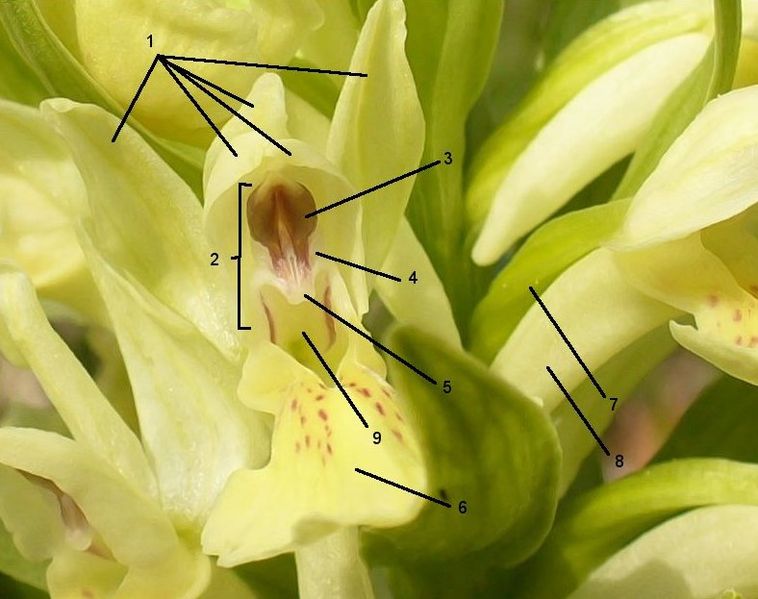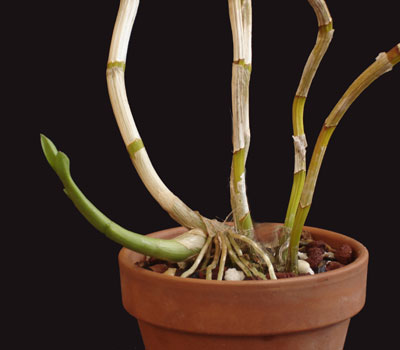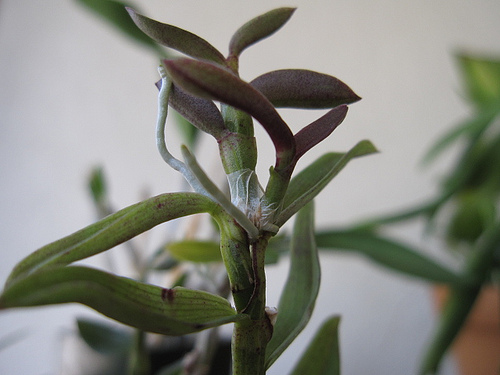Reproduction
Dendrobium officinale can reproduce
two different ways, sexually and asexually.
Sexual Reproduction
Dendrobium officinale is an orchid that can grow up to 9-35
cm in height and 2-5 mm in diameter. Dendrobium officinale blooms between May and
June every year. (He, Song, Luo, et al. 2009) Dendrobium officinale mainly reproduces asexually by
means of colonal propagation (aka by
sympodial or
keikis).
Although D. officinale does not have flashy
colors on its petals, it does have a colorful
labellum to attract pollinators (insects such as bees, or
birds). Once the pollinators have been attracted, they land on
the labellum and collect
pollinia from the
stamen. The pollinia is then taken by the pollinator to
another orchid where it is deposited on the stigma, which is
covered in a sticky substance. The pollinia then travels down
the
pistil to the ovary. Once inside the ovary the pollinia
joins with the
ovule resulting in fertilization and a seed begins to form.

Pictured right, critical reproductive structures*
1.Tepals
2.Gynostemium
3.
Anther
4.
Stamen
6.
Labellum
7.
Ovary
9.
Style
In order for the seeds to germinate they must be near a fungi in
which they can create a symbiotic relationship. Therefore, the
seeds normally fall near the mother orchid in order to benefit
from the original fungi too. The seedling begins to germinate
and becomes a
protocorm. Both the fungi and D. officinale benefit
from their new relationship because the fungi assists in
absorbing nutrients for the orchid and the orchid provides extra
sugars to the fungi. In this relationship, the fungi is
incorporated within the roots of D. officinale.
Asexual

Dendrobium
orchids are unique in the fact that they can also reproduce
asexually. When asexual reproduction occurs, a growth develops
along the
rhizome called a
sympodial. This sympodial becomes the new growth and then in
turn are replaced by a other sympodial. At the base of the
sympodial a
pseudobulb is formed which helps to store food and water.
Photo of sympodial growth on Dendrobium orchid

Dendrobium also can reproduce by a
keikis, which is an offshoot off of the mother plant. If the
light level is too low Dendrobium can reproduce by keikis instead of
flowering to produce a new plant. The keikis forms from sprouting
along the length of the stem. An accumulation of growth hormones is
at the base of the keikis, which produces the new growth.
Photo of keikis growth on Dendrobium stem.

Keikis picture courtesy of Kennis Wong,
Sympodial picture courtesy of David K. Sharpio,
Orchid picture courtesy of Jennifer Possley.
To find out more about the ways that D. officinale interact
fungi or other organisms check out my interactions page.
Return to Home page.
*Structures are of flower Dactylorhiza sambucina, not Dendrobium officinale.
